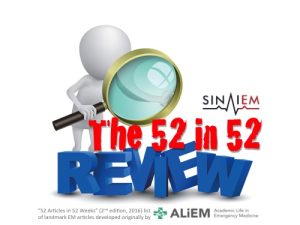Title: Prospective Validation of the San Francisco Syncope Rule to Predict patients With Serious Outcomes
Article Citation: Quinn, J. et al “Prospective Validation of the San Francisco Syncope Rule to Predict patients With Serious Outcomes” Annals of Emergency Medicine Volume 47, no. 5, May 2006.
What we already know about the topic: Syncope accounts for 1% to 2% of all ED visits annually. It can be the presenting symptoms for benign pathology or serious conditions such as arrhythmia, MI, PE, and occult hemorrhage.
Why this study is important: Specialty guidelines on syncope tend to be conservation due to the high stakes of adverse events leading to high admission rates. Prior studies have shown that patients admitted for syncope received little additional diagnostic evaluation. Validation of the San Francisco Syncope Rule could lead to improved risk stratification of Emergency Department patients with syncope. The San Francisco Syncope rules specifically looks for high risk features of syncope such a CHF, Hematocrit (Low), ECG changes, Shortness of breath or Shock (CHESS).
Brief overview of the study: The study design was prospective cohort study at a large teaching hospital. Patients were followed up at 30 days for serious complications of death, MI, arrhythmia, PE, stroke, subarachnoid hemorrhage, significant hemorrhage, anemia requiring transfusion or procedure/hospitalization related to the syncope. 791 visits were analyzed and the rule (image 1) was found to be 98% sensitive (95% CI 89% to 100%) and 56% specific (95% CI 52% to 60%) for predicting serious outcomes.
Limitations: My primary issues with this study are: (1) Single Center Study performed at the same center it was derived. (2) The rule is not designed for evaluation of specific pathology, just serious pathology in general. (3) Rule is not 100% sensitive. (4) Does not evaluate for long term negative outcomes.
Take home points: The use of the San Francisco Syncope Rule could be considered when risk stratifying patients with syncope in relation to discharged vs admission. Discretion should be used when blindly implementing this rule as the lower end of the confidence interval in 89% sensitive.
Comments: Further studies have failed to reproduce sensitivity as high as the original validation study.

